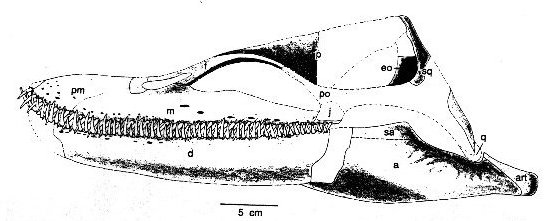 |
| Early depictions of elasmosaurs portrayed them as slender, snake-like predators |
The neck has been a great source of confusion since, with early depictions showing the elasmosaurs' neck as snake-like, capable of twisting into complicated loops and bends. The neck is less flexible as it is often portrayed. Nevertheless this would have improved the hydrodynamic properties of the body and aided in the capture of fast-moving prey.
A study conducted by Robin O'Keefe from Marshall University, West Virginia, has shown that the neck was part of a unique feeding system in the late Cretaceous elasmosaur species Aristonectes and Mortuneria. The large lower jaws bore a comb-like structure formed by many slender teeth which projected sideways; the teeth in the upper jaws extended downward and sideways. Combined with a deeply vaulted palate, this arrangement suggests that these elasmosaurs employed filter-feeding.
 |
| The comb-like teeth of Aristonectes would have allowed the creature to filter food from neckfuls of water |
The long neck enabled large volumes of water to be processed without decreasing the hydrodynamic shape of the body. Whales, in contrast, use their large mouths to store volumes of water. The hydrodynamic, elongated neck of the elamosaurs would certainly have been faster and maleable - vital in the predator-filled Mesozoic oceans.
A development in filter feeding is unique to these two elasmosaur species and provides an interesting example of convergent evolution. There are two families of whales: odontocetes are toothed active predators, while the mysticetes filter-feed using fibres of baleen to strain micro-organisms from mouthfuls of water. The elasmosaur fossils did not have any preserved soft tissue. Yet the arrangement of teeth would allow them to perform in a similar manner to the baleen fibres - mimicry in form and function, separated by hundreds of millions of years of evolutionary history.